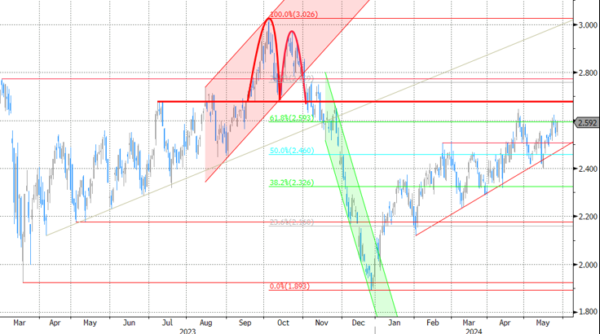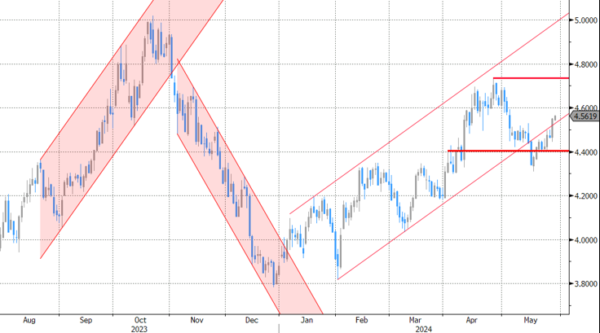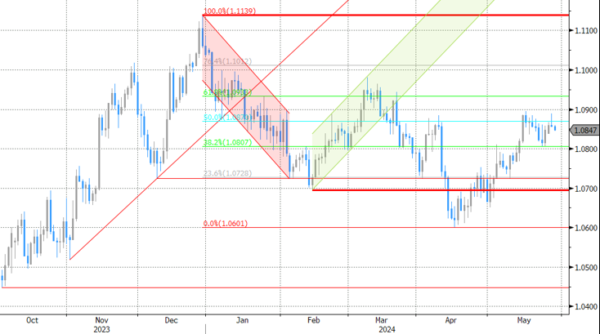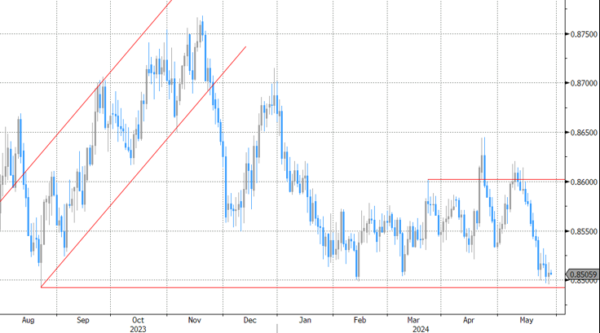Markets
Global bonds trading took a slow start after a long weekend in the US and the UK. Yields initially lost a few basis points. However, US Treasuries were hit by a triple whammy as the US session preceded. Mid-morning in the US, Fed’s Kashkari confirmed the more hawkish tone from last week’s Fed Minutes. The odds for the Fed to raise rates currently are quite low, but not completely off the table. In any case, the Fed needs (much) evidence before becoming confident to start easing. More or less at the same time, US consumer confidence unexpectedly reaccelerated from 97.5 to 102. Consumers’ assessment on the economy wasn’t unequivocally positive, but expectations on income and spending remained positive. Inflation is hardly seen slowing. The consumer confidence report and the Kashkari comments triggered a first down-leg in US Treasuries. Later, 2-y and 5-y US bond auctions only met with mediocre buying interest, further propelling rates. In a broader perspective, the curve move was interesting. Despite poor auctions of shorter maturities, this time the long end of the curve underperformed (2-y +3 bps, 10-y +8.5 bps, 30-y + 9.6 bps). With money markets already discounting only 1 rate cut this year, investors apparently are caution to place additional bearish bets at the short end of the curve, turning the focus further out. Also keep an eye at the 10-y real yield, which jumped more than 6.5 bps yesterday. German yields also changed course later in the session. Initially, some more hawkish ECB members (Knot, Holzmann) sounded quite confident that th disinflation process is gaining traction. Still, the move in the US at the end of the day also raised German yields between 2 bps (2-y) and 4.5 bps (10-y). US equities hesitated, but in the end held strong (Nasdaq +0.59%, new record close). The rise in yields helped to dollar to hold above first support levels. Admittedly, gains could have been bigger (DXY 104.61, EUR/USD close 1.0857 after testing 1.0890 intraday).
This morning, Asian equities suffer more from the sell-off in US Treasuries than was the case yesterday on WS. The broader rise in LT-yields also spreads to Japan (10-y yield 1.08%). The dollar tries to extend gains. The eco calendar is thin today, expect for the German CPI data. Monthly HICP is expected to rise a modest 0.2%, but unfavourable base effects might rise the Y/Y-measure to 2.7% from 2.4%. In case of an upward surprise, after yesterday’s global bond move, we’re keen to see the reaction at the long end of the curve. The German 10-y yield isn’t far away from the 2.65% April top. The US Treasury will sell $44bn 7-y notes. EUR/USD is locked in the 1.08/1.09 range.
News & Views
Australia’s monthly CPI unexpectedly gained traction in April. The yearly figure picked up from 3.5% in March to 3.6% compared to a 3.4% consensus. It is the second month in a row where annual inflation printed an increase, extending a potential bottoming out process that’s been going on since December last year. It underscores the need for the central bank to remain vigilant on the matter, even as yesterday’s retail sales suggest consumer fragility. Australia’s Bureau of Statistics singled out housing (4.9%, with rents rising 7.5%), food (3.8%) and transport (4.2%) as some of the major contributors. Electricity prices rose 4.2% but the government’s Energy Bill Relief Fund depresses the actual pressures. Without the rebates, prices would have risen 13.9%. Excluding categories including food & vegetables as well as holiday travel, core inflation in April rose by 4.1%, the same as in March. Core CPI in February hit a 2-yr low of 3.9% before creeping marginally higher. Australian swap rates rise between 3.6 and 4.7 bps. AUD/USD erased an earlier minor gain to trade more or less stable around 0.665.
The IMF in a statement this morning lifted Chinese growth prospects for 2024 and 2025. A stronger-than-expected expansion in the first quarter of the year is reflected in an upward revision to the annual target from 4.6% to 5%. Next year’s GDP growth would amount to 4.5% from 4.1% seen earlier. It nevertheless urged the country to address the ongoing housing slump that’s weighing on domestic demand and confidence. Aside from fiscal support, China’s low inflation also creates room for additional monetary support, it said. Authorities are wary to do so, however, fearing that increasing the monetary spread with the likes of the US may trigger capital outflows, pressure the yuan and create financial instability. The currency this morning already hits the lowest level since November at around USD/CNY 7.248. CNY hit a 17-yr low in September last year at USD/CNY 7.35.
Graphs
GE 10y yield
ECB President Lagarde clearly hinted at a summer (June) rate cut which has broad backing. EMU disinflation continued in April and brought headline CPI closer to the 2% target.. A more bumpy inflation path in H2 2024, the EMU economy gradually regaining traction and the Fed’s higher for longer US strategy make follow-up moves difficult. Markets have come to terms with that.
US 10y yield
The Fed in May acknowledged the lack of progress towards the 2% inflation objective, but Fed’s Powell indicated that further tightening was unlikely. Soft US early month data triggering a correction off YTD peak levels. However, the Fed minutes still showed internal debate whether policy is restrictive enough. Sticky inflation suggests any rate cut will be a tough balancing act. 4.37% (38% retracement Dec/April) already proved strong support for the US 10-y yield.
EUR/USD
Economic divergence, a likely desynchronized rate cut cycle with the ECB exceptionally taking the lead and higher than expected US CPI data pushed EUR/USD to the 1.06 area. From there, better EMU data gave the euro some breathing space. The dollar lost further momentum on softer than expected early May US data. Some further consolidation in the 1.07/1.09 are might be on the cards short-term.
EUR/GBP
Debate at the Bank of England is focused at the timing of rate cuts. Most BoE members align with the ECB rather than with Fed view but slower than expected April disinflation and a surprise general election on July 4 complicated matters. A June cut in line with the ECB looks improbable. Sterling extends a recent bull rally. A test of EUR/GBP’s 2024 YtD low (0.8489) is possible. We expect this important support level to hold.















